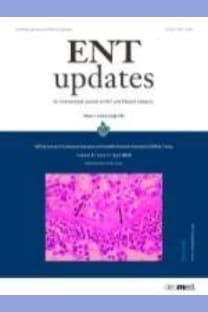Nasal response after exercise in swimmers, runners and handball players
Yüzücülerde, koşucularda ve hentbol oyuncularında egzersiz sonrası nazal yanıt
___
- 1. Fonseca MT, Voegels RL, Pinto KM. Evaluation of nasal volume by acoustic rhinometry before and after physical exercise. Am J Rhinol 2006;20:269–73.
- 2. McCafferty WB. Air pollution and athletic performance. Springfield, IL: Charles C. Thomas; 1981.
- 3. Carlisle AJ, Sharp NC. Exercise and outdoor ambient air pollution. Br J Sports Med 2001;35:214–22.
- 4. Daigle CC, Chalupa DC, Gibb FR, et al. Ultrafine particle deposition in humans during rest and exercise. Inhal Toxicol 2003; 15:539–52.
- 5. Cutrufello PT, Smoliga JM, Rundell KW. Small things make a big difference: particulate matter and exercise. Sports Med 2012; 42:1041–58.
- 6. Randolph CC. Allergic rhinitis and asthma in the athlete. Allergy Asthma Proc 2006;27:104–9.
- 7. Rundell KW. High levels of airborne ultrafine and fine particulate matter in indoor ice arenas. Inhal Toxicol 2003;15:237–50.
- 8. Bougault V, Boulet LP. Airway dysfunction in swimmers. Br J Sports Med 2012;46:402–6.
- 9. Andersen I, Camner P, Jensen PL, Philipson K, Proctor DF. Nasal clearance in monozygotic twins. Am Rev Respir Dis 1974; 110:301–5.
- 10. Yoshizaki K, Brito JM, Toledo AC, et al. Subchronic effects of nasally instilled diesel exhaust particulates on the nasal and airway epithelia in mice. Inhal Toxicol 2010;22:610–7.
- 11. Passàli D, Damiani V, Passàli GC, Passàli FM, Bellussi L. Alterations in rhinosinusal homeostasis in a sportive population: our experience with 106 athletes. Eur Arch Otorhinolaryngol 2004;261:502–6.
- 12. Fonseca MT, Machado JA, Pereira SA, Pinto KM, Voegels RL. Effects of physical exercise in nasal volume. Braz J Otorhinolaryngol 2006;72:256–60.
- 13. Ottaviano G, Staffieri A, Stritoni P, et al. Nasal dysfunction induced by chlorinate water in competitive swimmers. Rhinology 2012;50: 294–8.
- 14. Müns G, Singer P, Wolf F, Rubinstein I. Impaired nasal mucociliary clearance in long-distance runners. Int J Sports Med 1995;16:209–13.
- 15. Olséni L, Wollmer P. Mucociliary clearance in healthy men at rest and during exercise. Clin Physiol 1990;10:381–7.
- 16. Wolff RK, Dolovich MB, Obminski G, Newhouse MT. Effects of exercise and eucapnic hyperventilation on bronchial clearance in man. J Appl Physiol Respir Environ Exerc Physiol 1977;43:46–50.
- ISSN: 2149-7109
- Yayın Aralığı: 3
- Başlangıç: 2015
- Yayıncı: AVES
Level IIb lymph node metastasis in transglottic laryngeal squamous cell carcinoma
Yılmaz ÖZKUL, Rıza DÜNDAR, ABDÜLKADİR İMRE, Seçil ARSLANOĞLU, Elif DİNÇER, Düzgün ATEŞ, ERCAN PINAR, Kazım ÖNAL
Murat ŞEREFLİCAN, BETÜL ŞEREFLİCAN, Bengü TUMAN, Nadir GÖKSÜGÜR, Selcan KESGİN, Veysel YURTTAŞ
Clinical and histopathological presentations of sinonasal cancers in Komfo Anokye Teaching Hospital
Joseph OPOKU-BUABENG, Seth ACQUAH
AHMET HAMDİ KEPEKÇİ, Gökalp DİZDAR, ALİ BESTEMİ KEPEKÇİ
Taşkın TOKAT, Tolgahan ÇATLI, Mehmet Z ÖZÜER
Komfo Anokye Eğitim Hastanesinde sinonazal kanserlerin klinik ve histopatolojik özellikleri
Joseph OPOKU-BUABENG, Seth ACQUAH
MEHMET BURAK ÇİLDAĞ, Özüm TUNÇYÜREK, Ersen ERTEKİN, SONGÜL ÇİLDAĞ
Hipoksi parametreleri, fiziksel değişkenler veobstrüktif uyku apnesinin şiddet derecesi
Aynur YILMAZ AVCI, Suat AVCI, Hüseyin LAKADAMYALI, Erdinç AYDIN
Surgical intervention for traumatic facial paralysis: an analysis of 15 patients
ELİF BAYSAL, Secaattin GÜLŞEN, İSMAİL AYTAÇ, Sercan ÇIKRIKÇI, Burhanettin GÖNÜLDAŞ, Cengiz DURUCU, LÜTFİ SEMİH MUMBUÇ, MUZAFFER KANLIKAMA
Nasal response after exercise in swimmers, runners and handball players
